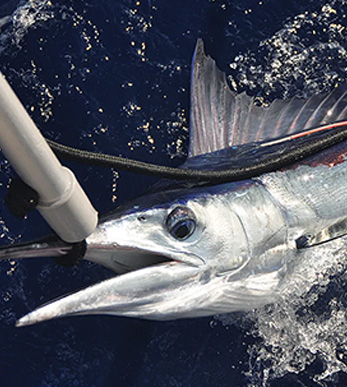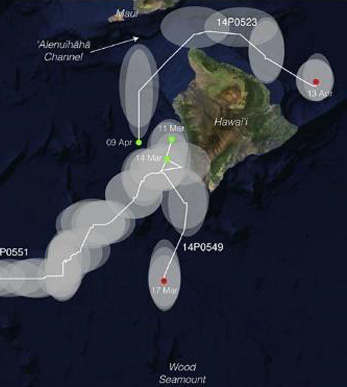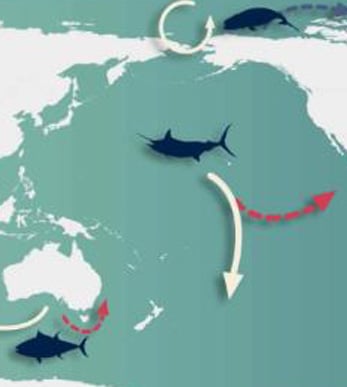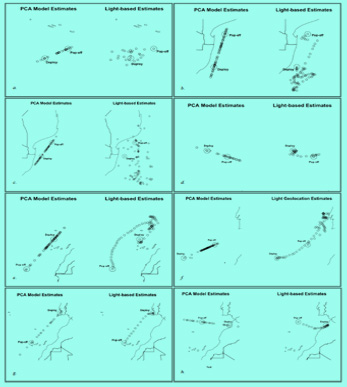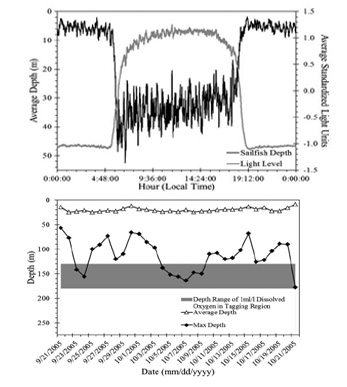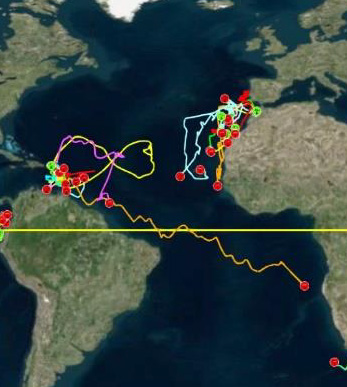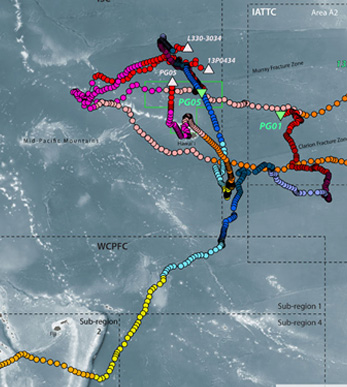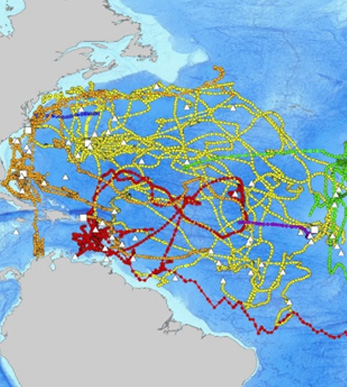Scientific Publications Based from IGFA Great Marlin Race Data
Entering the 12th year of the IGFA Great Marlin Race (IGMR), we take a look back on the research that has been made possible using the data collected by satellite tags deployed on marlin, sailfish, and spearfish species. With over 550 tags deployed and enough tracked mileage to circumnavigate the globe more than 32 times, the database from the IGMR is unrivaled in the world of citizen-science billfish research.
The IGFA’s dedication to billfish conservation through the IGMR has resulted in 12 peer-reviewed publications and has been used in legislation leading to the Billfish Conservation Act of 2012 and subsequent amendment in 2018 which made it illegal to import billfish species into the US. The passage of the BCA and amendment is one of the biggest steps forward ever for billfish conservation.
The IGFA Great Marlin Race, presented by Costa Sunglasses, is a research collaboration between IGFA and Stanford University and is sponsored by AFTCO, Bass Pro Shops and Cabela’s Outdoor Fund, EdgeWater Boats, and Release Boatworks.
Movement and thermal niche of the first satellite-tagged Mediterranean spearfish (Tetrapturus belone)
Martin C. Arostegui, Carmin D. Braun, Peter Gaube
This study comes from IGFA Representative Dr. Martini Arostegui at University of Washington and represents the first study on Mediterranean spearfish ever conducted using PSATs. Mediterranean spearfish are one of the least studied billfish with little known about their basic biology and behavior. The study examined movement patterns and temperature preference from the first PSAT deployed on the species. They found the fish to spend 93% of the day above 30m depth and that it exhibited a pattern of diel activity typically seen in billfish meaning increased activity levels and diving behavior occur during daytime and near-surface residency at night.
Movement ecology and stenothermy of satellite-tagged shortbill spearfish
Martin C. Arostegui, Carmin D. Braun, Peter Gaube
This study also comes from IGFA representative Dr. Martini Arostegui at University of Washington. Between February and April in 2015, six satellite tags were deployed on shortbill spearfish by IGFA Trustee Chase Offield and his father and former IGFA Chairman Packy Offield. Previously, no satellite tags had been deployed on shortbill spearfish and information on their thermal preferences and behavior was nearly nonexistent. As such, the goal of this research was to describe the movement ecology and thermal niche of this understudied species. Their study found that, on average, tagged spearfish spent greater than 90% of their time at depths less than 100 meters in water temperatures between 24 and 26 °C. Their narrow thermal distribution reported from this study suggests that they are less tolerant of colder water temperatures than other species of billfish.
One of the most interesting findings of this research relates to the diving behavior of shortbill spearfishes. Tag data from the IGMR and other studies have found that billfish have distinct diurnal diving behavior. During the day, most billfish species make periodic deep dives in search of prey and at night spend most of their time in the upper portion of the water column. Shortbill spearfish appear to exhibit the opposite behavior, typically residing near the surface during the day and diving repeatedly at night. It appears that they may dive at night to prey on mesopelagic (mid-water) species that typically reside in deeper waters beyond their thermal tolerance during the day but migrate closer to the surface at night. This is also supported by previous research that found that shortbill spearfish prey on a combination of epipelagic (surface) and mesopelagic species.
Ecological bridges and barriers in pelagic ecosystems
Briscoe, D.K., Hobday, A.J., Carlisle, A., Scales, K., Eveson, J.P., Arrizabalaga, H., Druon, J.N. and Fromentin, J.M.
This study was developed by an international group of scientists including our IGMR partners at Stanford University. The study used IGMR data along with tag data from other highly migratory species to examine the presence of ecological pathways, corridors, and barriers to movement based on favorable/unfavorable oceanic conditions. Many species use such pathways to move between habitats for the purpose of feeding or spawning but environmental variability can lead to conditions where individual fish may gain access to habitats previously outside the typical range or be restricted from regions typically visited. These changes in migratory pathways have significant implication for management and the authors investigate five such cases where ecological bridges and barriers to migration have occurred, including the effect of temperature changes along the equator due to La Niña on IGMR tagged blue marlin in the Pacific. They found the barrier present during the studied La Niña event limited movements across the equator that are typically found in tag blue marlin which may have important consequences to population mixing and access to favorable conditions for spawning. The study also identifies concerns with the changing climate should these El Niño and La Niña events increase in intensity or frequency.
Influence of temperature and oxygen on the distribution of blue marlin (Makaira nigricans) in the Central Pacific
Carlisle, A.B., Kochevar, R.E., Arostegui, M.C., Ganong, J.E., Castleton, M., Schratwieser, J. and Block
This study comes from our IGMR partners at Stanford University and is co-authored by IGFA Representative Dr. Martini Arostegui and President Jason Schratwieser. Results from this study were explored in the last publication discussed above. This study examined how temperature and oxygen influence movements of blue marlin in the Central Pacific. The study found the 2010 La Niña event created a barrier to blue marlin trans-equatorial movement due to cold, low oxygen water being upwelled along the equator compared to non-La Niña years. This restriction in movement has potential implications for future La Niña events relative to blue marlin migrations and habitat availability in the Pacific if migrations limit access to favorable feeding or spawning grounds especially with climate change likely to impact intensity and frequency of these events.
A principal component analysis of vertical temperature profiles for tracking movements of large pelagic fishes
Carmody, K.G., Mariano, A.J., Kerstetter
This study comes from Kathryn Carmody at Nova Southeastern University working with Dr. Arthur Mariano and Dr. David Kerstetter as part of Kathryn’s Masters degree research. This study used IGMR tag data and algorithms used to determine fish location to explore new statistical methods of determining location in species such as swordfish that do not see reliable light level data due to their behavioral traits limiting time spent at the surface in daylight hours. Current location algorithms used by tagging researchers apply sea surface temperature in combination with light and time to pinpoint where the fish travelled over its migration but these data are not available in some species like the aforementioned swordfish. To account for the missing light information, this study used a statistical methodology implementing principal component analysis using depth and temperature and compared their developed model to the accepted light-based models for an investigation of the accuracy and efficacy of their approach.
An analysis of sailfish daily activity in the Eastern Pacific Ocean using satellite tagging and recreational fisheries data
Pohlot, B. G., & Ehrhardt, N
This study comes from Bruce Pohlot, current IGFA Conservation Director, while he was working on his PhD at the University of Miami with Dr. Nelson Ehrhardt. The study explored sailfish behavior from a variety of data sources including PSATs and recreational fishery catch data. They found light and oxygen to influence the behavior of sailfish in the Eastern Pacific with higher activity levels and increased diving behavior when peak sunlight was present. The study also found a barrier to diving depth due to low dissolved oxygen in the region. The study provides evidence that sailfish vision is optimal with high light levels and their activity level is directly related to the amount of available light, finding increased activity even with small increases in light caused by the full moon.
Blue marlin (Makaira nigricans) horizontal movements in the Western South Atlantic
Wanick, E.W.
This study comes from Eduardo Wanick’s Master’s degree thesis working with Dr. David Kerstetter at Nova Southeastern University. Eduardo examined the movements of blue marlin in the North and South Atlantic to determine the extent of interactions between the two Atlantic regions. His research also examined blue marlin temperature residence between Atlantic and Pacific tagged fish to determine habitat preference.
Environmental influences and ontogenetic differences in vertical habitat use of black marlin (Istiompax indica) in the southwestern Pacific
Williams, S.M., Holmes, B.J., Tracey, S.R., Pepperell, J.G., Domeier, M.L. and Bennett
This study comes from Dr. Samuel Williams while working on his PhD from University of Queensland in Australia. This study examines the diving behavior of black marlin collected from PSATS including those deployed as part of the IGMR. They investigated the impact of environmental variables on diving and how different size classes of black marlin behave in relation to each other. They found that larger fish tend to dive deeper and spend more time at depth and hypothesized this was due to their differeces in foraging or physiology.
Connectivity of striped marlin from the Central North Pacific Ocean
Lam, Chi Hin, Clayward Tam, and Molly E. Lutcavage
This publication comes from a team at the Large Pelagics Research Center and Pacific Island Fisheries Group. The study implements a variety of billfish tagging data, including a sample from the IGFA Great Marlin Race, and genetic analyses to explore how connected the populations of striped marlin are across the Central North Pacific and beyond. Results indicated striped marlin undertake extensive movements across the central Pacific, revealing diverse seasonal dispersal patterns and potential coincidence with spawning locations. Genetic analysis revealed two genetic groups, an Australia, New Zealand, and Hawaii group and a Hawaii alone group, which suggests the Hawaii based fishery interacts with striped marlin from multiple locations. The study also confirmed striped marlin populations may be more connected than previously thought, with an individual swimming from the Central North Pacific to Australia. The authors suggest the results of the study indicate that striped marlin should be more collectively managed due to the interconnectivity between spatially distance locations.
First insights into the movements and vertical habitat use of blue marlin (Makaira nigricans) in the eastern North Atlantic
Freitas, C., Freitas, M., Andrzejaczek, S., Dale, J. J., Whippen, W., & Block, B. A
This publication, led by Carla Freitas, comes from a team from the Marine and Environmental Sciences Center, Institute of Marine Research, Regional Directorate for the Sea, Tightline, and IGFA Great Marlin Race Scientific partners at Stanford University. The study implements IGFA Great Marlin Race tagging data to explore the behavior and habitat use of blue marlin in the eastern North Atlantic. Results from the study revealed blue marlin spend 71% of their time in the upper 5m of the water column and 89% in the upper 50m. Their preferred temperature range was between 20 and 26℃ with clear diel differences in diving behavior where blue marlin remained at the surface at night and undertaking deeper dives to depths greater than 50m during the day. Authors suggest the highly migratory patterns of this vulnerable species in the eastern North Atlantic highlights the need for both local and international conservation measures. Depth-use patterns, particularly the high usage of the upper 5 m of the water column, make them susceptible to surface longline fisheries.
Global habitat loss of a highly migratory predator, the blue marlin (Makaira nigricans) in the eastern North Atlantic
Dale, J. J., Brodie, S., Carlisle, A. B., Castleton, M., Hazen, E. L., Bograd, S. J., & Block, B. A
This publication comes from the IGFA Great Marlin Race scientific team from Dr. Barb Block’s lab at Stanford University along with coauthors from University of California Santa Cruz, NOAA, and the University of Delaware. Lead author Dr. Jon Dale implements the global dataset of IGFA Great Marlin Race tags along with a suite of environmental information to explore how global habitat suitability is changing for blue marlin. The study revealed blue marlin habitat preference was most associated with sea surface temperature and that seasonal variation in habitat occurs primarily at the edges of the distributional range of the species. From 2000 to 2016, 96% of core habitat declined in suitability, with concurrent increased in suitable habitat poleward. The authors conclude the IGFA Great Marlin Race program is a successful application of citizen-0based science to develop a global telemetry dataset and that the present-day loss of highly suitable habitat suggests ocean warming may be making equatorial waters less suitable. They hypothesize blue marlin will respond by following preferred habitat as it shifts poleward.
For more information, check out the Marlin Magazine article on the publications here. Or the International Angler article here.
Seasonal and diel habitat use of blue marlin Makaira nigricans in the North Atlantic Ocean
Andrzejaczek, S., Mikles, C. S., Dale, J. J., Castleton, M., & Block
This publication comes from the IGFA Great Marlin Race scientific team from Dr. Barb Block’s lab at Stanford University and is led by Dr. Samantha Andrzejaczek. The study implements 66 blue marlin satellite tags, many of which were deployed through the IGFA Great Marlin Race, to explore the daily and seasonal behavior of blue marlin across the north Atlantic. Results found blue marlin migrations connected west and east Atlantic tagging locations and found long-term residency within small subregions of the Atlantic. Blue marlin were found to occupy lower latitudes during cooler months and higher latitudes during warmer periods. Diving data revealed blue marlin inhabited a shallow vertical habitat with deeper diving associated with higher sea surface temperatures, dissolved oxygen content and light level. The authors suggest the wide-ranging movements of blue marlin indicate that traditional spatial management measures, such as static marine reserves, are unlikely to be effective in reducing the fishing mortality of this species.

